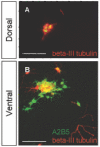Identification of two novel glial-restricted cell populations in the embryonic telencephalon arising from unique origins
- PMID: 17439658
- PMCID: PMC1858687
- DOI: 10.1186/1471-213X-7-33
Identification of two novel glial-restricted cell populations in the embryonic telencephalon arising from unique origins
Abstract
Background: Considerably less attention has been given to understanding the cellular components of gliogenesis in the telencephalon when compared to neuronogenesis, despite the necessity of normal glial cell formation for neurological function. Early proposals of exclusive ventral oligodendrocyte precursor cell (OPC) generation have been challenged recently with studies revealing the potential of the dorsal telencephalon to also generate oligodendrocytes. The identification of OPCs generated from multiple regions of the developing telencephalon, together with the need of the embryonic telencephalon to provide precursor cells for oligodendrocytes as well as astrocytes in ventral and dorsal areas, raises questions concerning the identity of the precursor cell populations capable of generating macroglial subtypes during multiple developmental windows and in differing locations.
Results: We have identified progenitor populations in the ventral and dorsal telencephalon restricted to the generation of astrocytes and oligodendrocytes. We further demonstrate that the dorsal glial progenitor cells can be generated de novo from the dorsal telencephalon and we demonstrate their capacity for in vivo production of both myelin-forming oligodendrocytes and astrocytes upon transplantation.
Conclusion: Based on our results we offer a unifying model of telencephalic gliogenesis, with the generation of both oligodendrocytes and astrocytes from spatially separate, but functionally similar, glial restricted populations at different developmental times in the dorsal and ventral CNS.
Figures












Similar articles
-
The tripotential glial-restricted precursor (GRP) cell and glial development in the spinal cord: generation of bipotential oligodendrocyte-type-2 astrocyte progenitor cells and dorsal-ventral differences in GRP cell function.J Neurosci. 2002 Jan 1;22(1):248-56. doi: 10.1523/JNEUROSCI.22-01-00248.2002. J Neurosci. 2002. PMID: 11756508 Free PMC article.
-
SOX2 expression levels distinguish between neural progenitor populations of the developing dorsal telencephalon.Dev Biol. 2011 Apr 1;352(1):40-7. doi: 10.1016/j.ydbio.2011.01.015. Epub 2011 Jan 21. Dev Biol. 2011. PMID: 21256837
-
Lines of glial precursor cells immortalised with a temperature-sensitive oncogene give rise to astrocytes and oligodendrocytes following transplantation into demyelinated lesions in the central nervous system.Glia. 1993 Sep;9(1):25-40. doi: 10.1002/glia.440090105. Glia. 1993. PMID: 8244529
-
Cell fate specification in the mammalian telencephalon.Prog Neurobiol. 2007 Sep;83(1):37-52. doi: 10.1016/j.pneurobio.2007.02.009. Epub 2007 Mar 7. Prog Neurobiol. 2007. PMID: 17517461 Review.
-
[Glial cells function as neural stem cells and progenitor cells].Sheng Li Xue Bao. 2017 Apr 25;69(2):207-217. Sheng Li Xue Bao. 2017. PMID: 28435980 Review. Chinese.
Cited by
-
There is more to a lipid than just being a fat: sphingolipid-guided differentiation of oligodendroglial lineage from embryonic stem cells.Neurochem Res. 2011 Sep;36(9):1601-11. doi: 10.1007/s11064-010-0338-5. Epub 2010 Dec 7. Neurochem Res. 2011. PMID: 21136155 Free PMC article.
-
DNA methylation map of mouse and human brain identifies target genes in Alzheimer's disease.Brain. 2013 Oct;136(Pt 10):3018-27. doi: 10.1093/brain/awt237. Epub 2013 Sep 11. Brain. 2013. PMID: 24030951 Free PMC article.
-
Structurally distinct LewisX glycans distinguish subpopulations of neural stem/progenitor cells.J Biol Chem. 2011 May 6;286(18):16321-31. doi: 10.1074/jbc.M110.201095. Epub 2011 Mar 8. J Biol Chem. 2011. PMID: 21385876 Free PMC article.
-
Oligodendrocyte/type-2 astrocyte progenitor cells and glial-restricted precursor cells generate different tumor phenotypes in response to the identical oncogenes.J Neurosci. 2013 Oct 16;33(42):16805-17. doi: 10.1523/JNEUROSCI.0546-13.2013. J Neurosci. 2013. PMID: 24133281 Free PMC article.
-
Precursor cell biology and the development of astrocyte transplantation therapies: lessons from spinal cord injury.Neurotherapeutics. 2011 Oct;8(4):677-93. doi: 10.1007/s13311-011-0071-z. Neurotherapeutics. 2011. PMID: 21918888 Free PMC article. Review.
References
-
- Mayer-Proschel M. Cell differentiation in the embryonic mammalian spinal cord. J Neural Transm Suppl. 1999;55:1–8. - PubMed
-
- Gregori N, Proschel C, Noble M, Mayer-Proschel M. The tripotential glial-restricted precursor (GRP) cell and glial development in the spinal cord: generation of bipotential oligodendrocyte-type-2 astrocyte progenitor cells and dorsal-ventral differences in GRP cell function. J Neurosci. 2002;22:248–256. - PMC - PubMed
Publication types
MeSH terms
Substances
Grants and funding
LinkOut - more resources
Full Text Sources
Other Literature Sources

